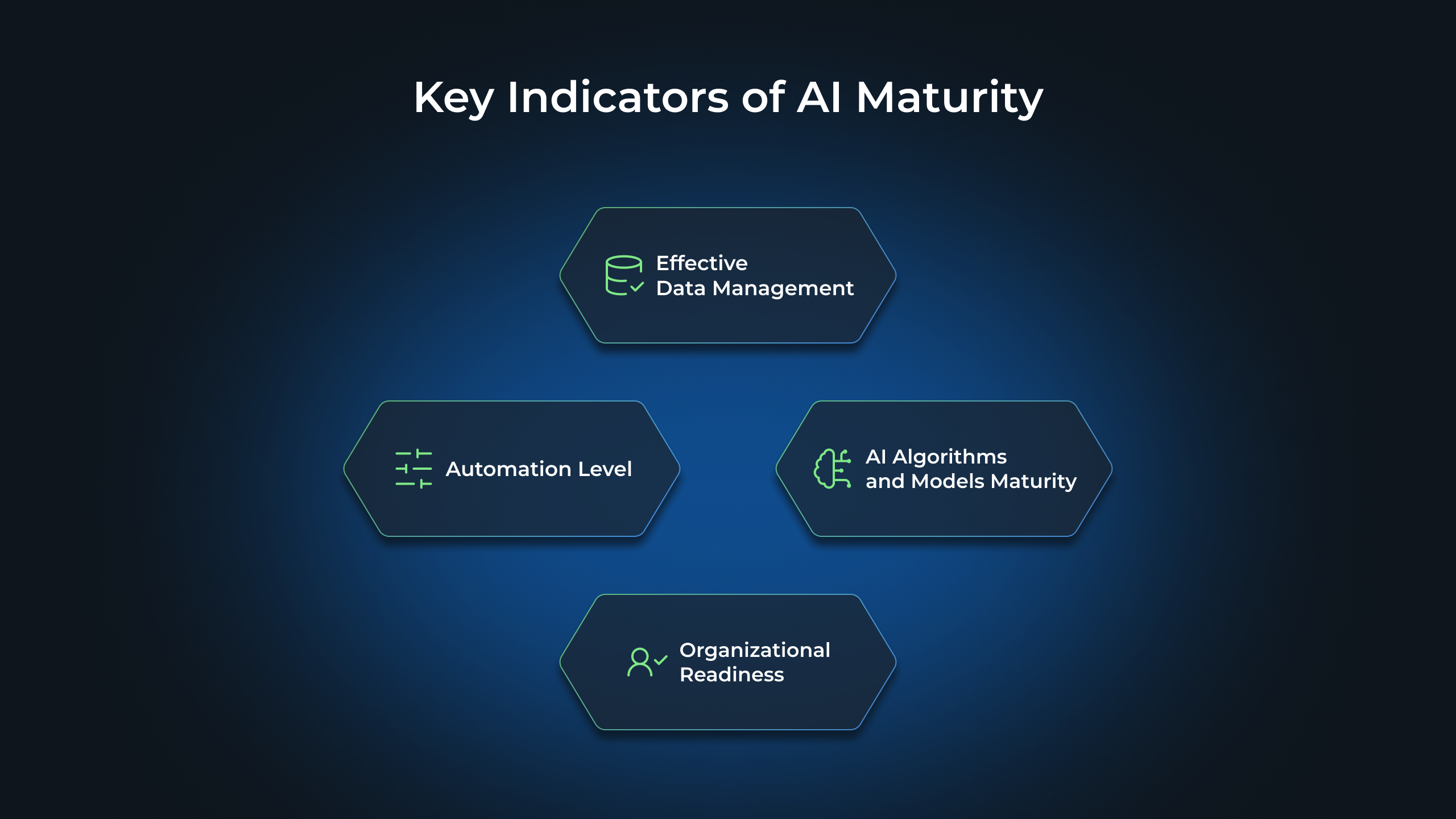Artificial Intelligence (AI) has become a buzzword in today’s ever-evolving world of technology. From self-driving cars to virtual assistants, AI is transforming various industries. However, it is crucial for businesses to understand and harness the potential of AI in a strategic manner. This is where the concept of AI maturity comes into play. In this article, we will explore the different aspects of AI maturity – from understanding its definition to measuring and enhancing it for future growth. We at WeSoftYou, a leading software development company with proven track record in AI technologies, have witnessed the impact that AI maturity can have on businesses. From our experience, we have identified the stages, indicators, challenges, and strategies associated with AI maturity. So, let’s dive deeper into the world of AI maturity and its significance for businesses.
The Concept of AI Maturity
Before we delve into the stages and measurement of AI maturity, it is crucial to understand what AI maturity actually means. AI maturity refers to the level of development, adoption, and optimization of AI capabilities within an organization. It is a journey that businesses embark upon to unlock the full potential of AI technologies. As an organization progresses through the stages of AI maturity, it gains a deeper understanding of AI’s capabilities and starts leveraging them to drive innovation and improve business outcomes.
AI maturity can be defined as the process of developing, integrating, and continuously improving AI capabilities within an organization. It involves building a solid foundation of knowledge, skills, and infrastructure needed to effectively leverage AI technologies. At each stage of AI maturity, organizations gain new insights, overcome challenges, and strengthen their AI capabilities.
But what does it really mean to be AI mature? It means having a clear vision and strategy for AI adoption, along with the necessary resources and expertise to execute that strategy. It means having a culture that embraces AI and encourages experimentation and learning. It means having the right data infrastructure and governance practices in place to ensure the quality and security of AI-driven insights. And it means having the ability to measure and track the impact of AI on business outcomes, and to continuously improve and optimize AI models and algorithms.
Importantly, AI maturity is not just a buzzword; it plays a vital role in the success of businesses in the digital age. With AI becoming more prevalent across industries, organizations need to embrace AI maturity to stay competitive. Advanced AI capabilities enable businesses to automate repetitive tasks, make data-driven decisions, personalize customer experiences, and gain a competitive edge. Embracing AI maturity positions businesses to be at the forefront of innovation and adapt to rapidly changing market dynamics.
So, how does an organization progress through the stages of AI maturity? It starts with the initial stage of AI awareness, where organizations begin to explore and understand the potential of AI technologies. This is followed by the stage of AI experimentation, where organizations start piloting AI projects and learning from the results. The next stage is AI integration, where organizations start integrating AI capabilities into their existing processes and systems. Finally, organizations reach the stage of AI optimization, where they continuously improve and optimize their AI models and algorithms to drive better business outcomes.
Throughout this journey, organizations face various challenges and obstacles. They need to overcome technical challenges, such as data quality and integration issues. They need to address ethical and legal considerations, such as privacy and bias in AI algorithms. And they need to navigate organizational and cultural barriers, such as resistance to change and lack of AI talent. Overcoming these challenges requires a holistic approach, involving collaboration across different functions and stakeholders, and a commitment to continuous learning and improvement.
In conclusion, AI maturity is a critical journey that organizations undertake to unlock the full potential of AI technologies. It involves developing, integrating, and continuously improving AI capabilities within an organization. By embracing AI maturity, organizations can automate tasks, make data-driven decisions, personalize customer experiences, and gain a competitive edge. However, the journey towards AI maturity is not without its challenges. Organizations need to address technical, ethical, and organizational barriers to successfully navigate through the stages of AI maturity.
Main Stages of AI Maturity
AI maturity can be seen as a progression through four distinct stages: awareness, understanding, adoption, and mastery. Each stage represents a different level of AI integration and utilization within an organization. Let’s take a closer look at each stage:
Initial Stage: Awareness
In the initial stage of AI maturity, organizations become aware of AI and its potential applications. They start exploring AI technologies, attending conferences, and reading articles to gain a basic understanding of AI’s capabilities. Awareness at this stage helps organizations identify potential use cases for AI within their industry and sets the foundation for further exploration.
During this stage, organizations may also engage in discussions with industry experts and thought leaders to gain insights into the latest AI trends and developments. They may attend workshops and webinars to learn about real-world AI implementations and success stories. By actively seeking knowledge and information, organizations in the awareness stage can begin to envision the possibilities and benefits of AI for their own operations.
Intermediate Stage: Understanding
As organizations progress to the intermediate stage, they deepen their understanding of AI concepts and technologies. They invest in training programs, hire AI experts, and collaborate with AI-focused partners, like WeSoftYou, to gain hands-on experience. This stage involves building technical expertise and developing a clear vision of how AI can be applied to drive business value.
During this stage, organizations may conduct internal workshops and training sessions to educate their employees about AI and its potential impact on their roles and responsibilities. They may also engage in proof-of-concept projects to test the feasibility of AI solutions in specific areas of their operations. By actively involving their workforce in the learning process, organizations in the understanding stage can foster a culture of innovation and continuous improvement.
Advanced Stage: Adoption
In the advanced stage, organizations actively adopt AI technologies and integrate them into their existing systems and processes. This stage involves piloting AI projects, implementing AI algorithms, and leveraging AI-driven insights to make data-informed decisions. Organizations at this stage witness tangible improvements in operational efficiency, customer satisfaction, and overall business performance.
During this stage, organizations may establish dedicated AI teams or centers of excellence to drive AI adoption across the organization. These teams collaborate with different departments and stakeholders to identify AI opportunities and develop customized solutions. By integrating AI into their day-to-day operations, organizations in the adoption stage can unlock new levels of productivity, agility, and competitiveness.
Final Stage: Mastery
The final stage of AI maturity represents the culmination of an organization’s AI journey. At this stage, organizations have mastered AI technologies and achieved full integration and optimization across their operations. They are pioneers in AI adoption and actively drive AI-driven innovation within their industry. Organizations at the mastery stage continuously push the boundaries of AI capabilities, leveraging cutting-edge technologies and staying ahead of the competition.
During this stage, organizations may collaborate with research institutions and universities to explore emerging AI technologies and contribute to the advancement of the field. They may also participate in industry conferences and events as keynote speakers or panelists, sharing their knowledge and experiences with others. By constantly seeking new ways to leverage AI, organizations in the mastery stage can maintain their competitive edge and shape the future of their industry.
AI Maturity Measurement
Measuring AI maturity is a crucial aspect of the AI journey as it provides organizations with insights into their progress and areas of improvement. It allows them to gauge how well they are leveraging AI technologies and identify opportunities for growth. Let’s explore the key indicators of AI maturity and the challenges associated with measuring it in more detail.
Key Indicators of AI Maturity

Measuring AI maturity involves assessing various factors that contribute to the organization’s AI capabilities. These factors include technical infrastructure, data strategy, talent development, and AI adoption. By evaluating these indicators, organizations can gain a comprehensive understanding of their AI maturity level.
One key indicator of AI maturity is the organization’s ability to collect and analyze data effectively. This involves having robust data management systems in place, as well as the capability to extract meaningful insights from the data. Organizations that have successfully implemented AI technologies often have advanced data analytics capabilities, allowing them to make data-driven decisions and optimize their operations.
Another indicator of AI maturity is the level of automation achieved through AI. Organizations that have reached a high level of AI maturity have successfully automated various processes and tasks using AI technologies. This automation not only improves efficiency but also frees up employees’ time to focus on more strategic and creative tasks.
The maturity of AI algorithms and models is also a crucial indicator of AI maturity. Organizations that have invested in developing and refining their AI algorithms and models are more likely to achieve higher levels of AI maturity. These organizations continuously improve their AI capabilities by leveraging advanced algorithms and models, allowing them to deliver more accurate and reliable results.
Lastly, the overall organizational readiness to embrace AI is an essential indicator of AI maturity. Organizations that have a culture of innovation and a strong commitment to AI adoption are more likely to achieve higher levels of AI maturity. This readiness includes having leadership support, clear AI strategies, and a willingness to invest in AI technologies and talent development.
Challenges in Measuring AI Maturity
Measuring AI maturity can be challenging due to various factors that organizations face. One common challenge is the limited availability of data. Organizations may struggle to collect sufficient and high-quality data to assess their AI maturity accurately. This challenge can be overcome by implementing robust data collection processes and leveraging external data sources when necessary.
The lack of skilled AI talent is another significant challenge in measuring AI maturity. Organizations may find it challenging to find and retain professionals with the necessary AI expertise to evaluate their AI capabilities. To address this challenge, organizations can invest in talent development programs, collaborate with academic institutions, and partner with AI experts to bridge the skills gap.
Data privacy concerns also pose challenges in measuring AI maturity. Organizations must ensure that they comply with relevant data protection regulations and maintain the privacy and security of the data they collect. Implementing robust data governance frameworks and adopting privacy-enhancing technologies can help address these concerns and enable accurate measurement of AI maturity.
Resistance to change is yet another common challenge in measuring AI maturity. Some employees may be hesitant to embrace AI technologies due to fear of job displacement or concerns about the reliability of AI systems. Overcoming this resistance requires effective change management strategies, clear communication about the benefits of AI, and providing training and support to employees to help them adapt to the changing work environment.
In conclusion, measuring AI maturity is a complex task that involves assessing various indicators such as technical infrastructure, data strategy, talent development, and AI adoption. While there are challenges associated with measuring AI maturity, organizations can overcome them by implementing the right strategies and approaches. By accurately measuring AI maturity, organizations can identify areas for improvement and drive continuous growth in their AI capabilities.
AI Maturity Enhancement
Enhancing AI maturity is a continuous process that requires a strategic approach and organizational commitment. It involves more than just implementing AI technologies; it requires a holistic transformation of the entire organization. Let’s explore some strategies for improving AI maturity and the role of leadership in this journey.
Strategies for Improvement
To enhance AI maturity, organizations should invest in developing AI talent, fostering a data-driven culture, and creating an ecosystem of AI-related partnerships. Developing AI talent involves not only hiring data scientists and AI experts but also upskilling existing employees to understand and work with AI technologies. This can be done through training programs, workshops, and certifications.
In addition to talent development, fostering a data-driven culture is crucial for AI maturity. This involves creating a work environment where data is valued and used to drive decision-making. Organizations should encourage employees to collect, analyze, and interpret data to gain insights and make informed decisions. This can be achieved by providing the necessary tools and resources, promoting data literacy, and recognizing and rewarding data-driven initiatives.
Furthermore, creating an ecosystem of AI-related partnerships can greatly accelerate AI maturity. Organizations can collaborate with external partners, such as research institutions, startups, and technology vendors, to access cutting-edge AI technologies, exchange knowledge, and leverage shared resources. These partnerships can provide access to specialized expertise, enable faster innovation, and help organizations stay at the forefront of AI advancements.
Streamlining data governance practices is also essential for enhancing AI maturity. Organizations should establish clear policies and procedures for data collection, storage, and usage. This includes ensuring data privacy and security, defining data quality standards, and implementing effective data governance frameworks. By having robust data governance practices in place, organizations can ensure the reliability and integrity of the data used for AI initiatives.
Additionally, organizations can leverage the expertise of software development companies like WeSoftYou to fast-track their AI maturity journey. These companies have experience in developing AI solutions and can provide guidance, support, and customized solutions to help organizations overcome challenges and accelerate their AI adoption.
Role of Leadership in AI Maturity Enhancement
Leadership plays a pivotal role in driving AI maturity within an organization. Leaders need to champion AI initiatives, create a vision for AI adoption, and allocate resources for AI projects. They should actively communicate the benefits of AI to stakeholders and inspire a sense of urgency and excitement about AI adoption.
Furthermore, leaders should foster a culture of experimentation and innovation. They should encourage employees to explore new AI technologies, experiment with different approaches, and learn from failures. By creating a safe environment for experimentation, leaders can empower their teams to take risks, learn from mistakes, and continuously improve AI initiatives.
Collaboration between business and technical teams is also crucial for AI maturity enhancement. Leaders should encourage cross-functional collaboration and ensure that business objectives are aligned with technical capabilities. This involves breaking down silos and promoting open communication and knowledge sharing between different departments. By fostering collaboration, leaders can ensure that AI initiatives are driven by business needs and are aligned with the organization’s overall strategy.
Lastly, leaders should ensure that ethical considerations are integrated into AI practices. They should establish guidelines and frameworks for responsible AI development and usage. This includes addressing issues such as bias, transparency, and accountability. By prioritizing ethics in AI, leaders can build trust with stakeholders and ensure that AI is used in a fair and responsible manner.
In conclusion, enhancing AI maturity is a complex and multifaceted journey. It requires organizations to invest in talent development, foster a data-driven culture, create partnerships, streamline data governance practices, and seek external expertise. Leadership plays a critical role in driving AI maturity by championing AI initiatives, fostering a culture of experimentation, promoting collaboration, and ensuring ethical AI practices. By taking a strategic and holistic approach, organizations can unlock the full potential of AI and gain a competitive edge in the digital era.
How to Implement AI Maturity in Your Business?
Learn how to implement AI maturity within your business. Following these steps will not only lead to AI adoption but will cultivate a thriving ecosystem of AI maturity, positioning your business strategically for the challenges and opportunities that lie ahead.
- Align with Business Goals
Defining clear objectives that synchronize AI initiatives with overarching business goals is the foundational step toward achieving AI maturity. It ensures that every facet of your AI strategy is purposeful and directly contributes to the success of the organization. This alignment creates a seamless integration of AI into the larger business strategy, unlocking its full potential for AI maturity.
- Build a Robust Infrastructure
Investing in a comprehensive AI infrastructure is crucial for navigating the entire AI lifecycle. This involves creating a solid foundation that supports activities from data acquisition and preparation to model development, deployment, and continuous monitoring. A robust infrastructure not only facilitates the smooth operation of AI processes but also enables the integration of AI insights into daily operations, enhancing overall efficiency and contributing to the implementation of AI maturity.
- Foster a Data-Driven Culture
Cultivating a data-driven culture is pivotal for successful AI implementation and the realization of AI maturity. This step involves encouraging collaboration among data scientists, domain experts, and business leaders. By creating an environment where data insights are valued and integrated into decision-making processes, organizations can maximize the impact of AI across various facets of their operations, fostering the culture necessary for the successful implementation of AI maturity.
- Prioritize Scalability and Flexibility
Scalability and flexibility are critical considerations in designing AI architecture for AI maturity. The goal is to ensure that the infrastructure can adapt to the evolving needs and challenges of the business landscape. Prioritizing scalability allows for growth, while flexibility ensures the agility to adjust AI models in response to changing requirements, ultimately future-proofing your AI strategy and contributing to the overall AI maturity.
- Continuous Learning Mindset
Embracing a continuous learning mindset is essential for organizations committed to AI maturity. Recognizing that the AI landscape is dynamic, this step encourages a culture of ongoing learning, adaptation, and refinement. By staying abreast of emerging insights and technologies, businesses can position themselves to leverage the latest advancements in AI, maintaining a strategic edge in their respective industries and fostering a continuous learning environment for sustained AI maturity.
By following these practical steps, businesses can not only adopt AI but also cultivate a thriving ecosystem of AI maturity that strategically positions them for the challenges and opportunities of the future.
Future of AI Maturity
The future of AI maturity holds immense potential for businesses. Let’s explore some predicted trends and the impact of AI maturity on future technologies.
Trends in AI Maturity
As AI continues to advance, we can expect increased automation, enhanced natural language processing, improved predictive analytics, and the emergence of hybrid AI-human systems. These predicted trends in AI maturity have the potential to revolutionize industries and reshape the way businesses operate.
Increased automation will streamline processes, reduce human error, and improve efficiency. Tasks that were once time-consuming and repetitive can now be automated, allowing employees to focus on more strategic and creative work.
Enhanced natural language processing will enable AI systems to better understand and interpret human language. This will have a significant impact on customer service, as chatbots and virtual assistants will be able to provide more accurate and personalized responses to customer queries.
Improved predictive analytics will empower businesses to make data-driven decisions and anticipate future trends. By analyzing large volumes of data, AI systems can identify patterns, detect anomalies, and provide valuable insights that can drive business growth.
The emergence of hybrid AI-human systems will combine the strengths of both AI and human intelligence. This collaboration will enable businesses to leverage the computational power of AI while benefiting from human creativity, empathy, and problem-solving skills.
Impact of AI Maturity on Future Technologies
AI maturity will play a pivotal role in shaping future technologies. It will enable the development of more sophisticated AI algorithms, improved recommendation systems, and personalized AI-driven experiences.
With AI maturity, algorithms can become more advanced, allowing AI systems to process and analyze complex data sets with greater accuracy and efficiency. This will lead to more accurate predictions, personalized recommendations, and enhanced user experiences.
Improved recommendation systems will revolutionize industries such as e-commerce, entertainment, and healthcare. AI algorithms will be able to understand user preferences, analyze their behavior, and provide tailored recommendations that align with their individual needs and preferences.
Personalized AI-driven experiences will become more prevalent as AI maturity progresses. From personalized shopping experiences to personalized healthcare recommendations, AI systems will be able to cater to individual needs and provide customized solutions that enhance customer satisfaction.
AI maturity will further catalyze the adoption of technologies like machine learning, robotics, and computer vision, leading to new breakthroughs and opportunities. Machine learning algorithms will become more sophisticated, enabling AI systems to learn and improve from experience. Robotics will become more advanced, allowing for the automation of complex tasks in various industries. Computer vision will enable AI systems to analyze and interpret visual data, opening up new possibilities in fields such as autonomous vehicles, surveillance, and healthcare diagnostics.
In conclusion, AI maturity is a journey that organizations must undertake to unlock the full potential of AI technologies. From understanding the concept of AI maturity to measuring and enhancing it, businesses need to navigate through various stages and challenges. The future of AI maturity holds great promise, with predicted trends such as increased automation, enhanced natural language processing, improved predictive analytics, and the emergence of hybrid AI-human systems. The impact of AI maturity on future technologies is vast, ranging from the development of more sophisticated AI algorithms to the creation of personalized AI-driven experiences. It is an exciting time for businesses to embrace AI maturity and leverage its potential for growth and innovation.
At WeSoftYou, we understand the importance of AI maturity and its impact on businesses. With our expertise in software development and AI technologies, we can help your organization embark on its AI maturity journey and drive meaningful outcomes. Contact us today for a free consultation or project estimation, and let’s embark on this transformative journey together.
FAQ
AI maturity refers to the level of development, adoption, and optimization of AI capabilities within an organization. It represents the organization’s progress in leveraging AI technologies to drive innovation and improve business outcomes.
The stages of AI maturity include awareness, understanding, adoption, and mastery. Each stage represents a different level of AI integration and utilization within an organization.
AI maturity enables businesses to automate tasks, make data-driven decisions, personalize customer experiences, and gain a competitive edge. It positions businesses at the forefront of innovation and enables them to adapt to rapidly changing market dynamics.
The future of AI maturity holds immense potential for businesses. Predicted trends include increased automation, enhanced natural language processing, improved predictive analytics, and the emergence of hybrid AI-human systems. AI maturity will continue to shape future technologies and drive transformation across industries.
Contact us today for a free consultation or project estimation to embark on your AI maturity journey.





















